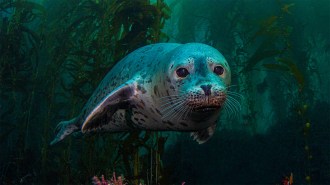Sperm whales may team up to herd prey
Data recorders yield first hints of coordinated feeding behavior
PORTLAND — Sperm whales sometimes collaborate when they forage the depths, new tracking data suggest, with some individuals herding prey into dense schools while others lunge into the fray and feed.

Scientists have long known that sperm whales, like many other toothed whales, form long-lasting social groups that typically consist of females and their young. While some researchers have suggested that the females in such groups collaboratively raise their young, the new data are the first to hint that the whales may engage in tag-team hunting. Bruce Mate, director of Oregon State University’s Marine Mammal Institute in Newport reported February 22 at the American Geophysical Union’s Ocean Sciences meeting.
In 2007 and 2008, Mate and his colleagues tagged sperm whales in the Gulf of California with a new type of data-gathering sensor. These hockey-puck-size instruments included a Global Positioning System receiver, which gathered data when the creatures were at the ocean’s surface, and other sensors that recorded water depth. In essence, Mate said, the instruments are flight data recorders for whales.
After taking data once every two seconds for as long as 28 days the instruments broke free and floated to the ocean surface, where they could be recovered by the researchers.
One of the whale groups the team studied consisted of between 10 and 15 individuals, three of which were tagged with recorders. Data showed that during some deep dives, whales zigzagged back and forth or suddenly surged forward, probably when they foraged on the Humboldt squid prevalent in the area. Sometimes the three tagged whales, presumably accompanied by others in the group, dove to great depths at the same time.
“We expected their dives to be similar, but often one of the three whales went deeper than the other two,” Mate said. This behavior is similar to that of sea lions and dolphins, which sometimes collaboratively prey upon fish by herding them into tight groups known as “bait balls.”
Mate and his colleagues speculate that the whale that dove deepest during each coordinated excursion helped prevent squid from escaping downward.
Sperm whales engaging in such behavior apparently share deep-diving patrol duty, Mate said, probably because the forays — which sometimes extend to depths of 1,500 meters — are physiologically stressful.
The new findings suggest but don’t prove collaborative foraging among sperm whales, comments Kelly Benoit-Bird, a biological oceanographer at Oregon State’s main campus in Corvallis. For one thing, she notes, the team’s data reveal the behavior of the whales but not their prey, and it’s not clear that squid respond to groups of predators by forming concentrated “bait balls” the same way that fish sometimes do.
Mate and his colleagues are now working to address that issue. Developing a technique to observe squid at depth is a somewhat difficult task, he notes, because unlike fish squid don’t have air-filled bladders that show up well on sonar images.
Meanwhile, the new data recorders deployed by Mate and his colleagues can also be used for other behavioral research in whales. For instance, Mate suggests, the instruments could reveal how whales respond to various sources of aquatic noise such as sonar or the often intense pressure pulses generated during submarine seismic surveys used in research or oil and gas exploration.






